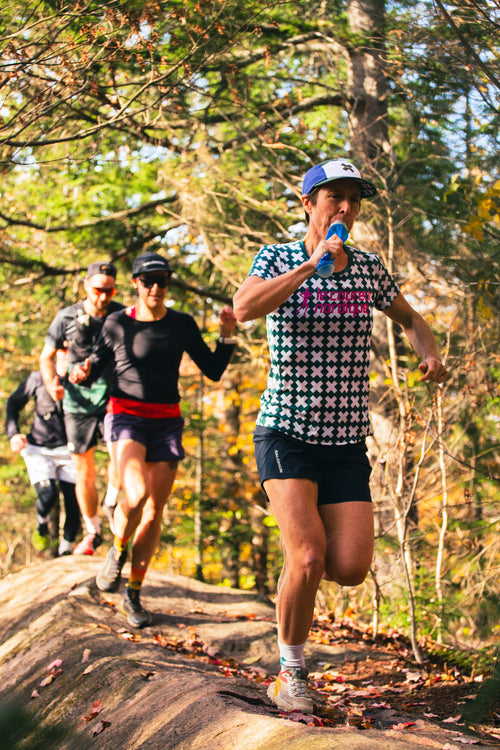
Alister Gardner
SPORT NUTRITION 101
The basics of fueling for endurance sport
We all come from different sporting backgrounds, different levels of fitness and have different aims. The one thing that unites us is how we fuel. Whether you are a hockey player or a long distance runner, the same basic rules apply.


Table of Contents:
- ENERGY
- HYDRATION and ELECTROLYTES
- RECOVERY
- NUTRITION BLOGS

1. ENERGY
The primary source of fuel for medium to high intensity sports like running and cycling are carbohydrates. Simple carbohydrates are quickly and easily absorbed by the body. They’re also known as fast burning carbohydrates, or quick release carbohydrates. More complex carbohydrates (also know as Slow burning carbs) take more time to be digested.
Why do we need to fuel during a workout?
Our bodies have a reserve of simple carbohydrates called glycogen. It’s stored in the muscles and liver and can provide about 60-90 minutes worth of energy, depending on intensity and prior recovery (tapering).
“Typically 25 grams of carbohydrates (100 calories) should be consumed every 30-45 minutes. ”
Bonk town

After 60 minutes, our reserves will become low and our bodies will try to preserve the last amount. As a result, we’ll start to slow down and feel sluggish. We may even start to feel dizzy and sick. This is where the expression bonking comes from, or ''hitting the wall'', as it is often described in marathon running.
The graph is a visualisation of our glycogen reserve dropping over 120 minutes. However, bonking does not have a precise threshold. What we want to do is avoid coming close to that line .
So how do we avoid bonking?
The answer is by consuming carbohydrates during your workout. If finishing the race requires more fuel than our glycogen reserves can provide, we need to consume extra carbs to help us perform well throughout. The aim is to keep the reserves topped up rather than fueling once they are low.
How to fuel?
Energy gels, energy chews and sports bars are all options. The reason why these are popular (more so than a banana or rice) is that they are very portable, easier to eat and usually easy to digest. For bigger workouts, it is also important to fuel before and after too.
How often to fuel during effort?
Typically 25 grams of carbohydrates (100 calories) should be consumed every 30-45 minutes. This can vary depending on the length of the effort and intensity, as well as your body type. In race conditions, some athletes will consume as much as 400 calories per hour. That's 4 XACT ENERGY Fruit bars every hour.
The table below is a guide to fueling a half marathon to marathon race.
| DURATION OF EXERCISE | AMOUNT OF CARBS NEEDED | FUEL amount |
|---|---|---|
| 45-75 MINS | UPTO 30G/HOUR | ~ 1 XACT ENERGY (100 cals) |
| 1-2.5 HOURS | 30-60 G / HOUR | ~ 1 -2 bars (100-200 cals) / hr |
| 2.5+ HOURS | Upto 90 G / HOUR | ~ 3 bars (300 cals) / hr |
| 2 + HOURS (high intensity) Or 3+ ultra distance | 105 G / HOUR | 4+ bars (400+ cals) / hr |
Nutrition Strategies to Optimize Performance in Distance Runners
Carbohydrate feeding during exercise
2. HYDRATION and ELECTROLYTES
When we think of hydration during sport, we tend to think about two things:
1. quenching our thirst, and
2. replacing the minerals that we've lost through sweat
We should look at hydration with a more consolidated approach:
We need to maintain our body's fluid levels (limit our weightloss from sweating) and in doing so ensure we maintain that balance between fluids and electrolytes.

We sweat to help control our body temperature (thermoregulation).
In hot conditions or during hard workouts we sweat more, in cooler conditions and easier workouts, we sweat less.
This means that, unlike our carbohydrate intake, our fluid intake varies from one activity to the next, all depending on effort and temperature. We talk about how to calculate your hydration needs here.
What shouldn’t vary is the ratio of fluids to electrolytes. For shorter workouts, less than 60 minutes for example, we can get by on drinking only water, because the change in the sodium to water ratio in our bodies will be very small.
For longer workouts we need to consider how much we are drinking and what the concentration of electrolytes is.
Research suggests that the optimal ratio is around 1 gram of sodium per litre. This both helps the body absorb water, and replaces what is lost through sweating
Sodium intake and post-exercise rehydration in man
Sweating Rate and Sweat Sodium Concentration in Athletes: A Review of Methodology and Intra/Interindividual Variability
The most important electrolyte is sodium. It is a co-transporter, meaning it is used to help the water transit through our body. Without it, our bodies would not absorb the water (ever had that sloshy feeling in your stomach?).

The graph explained
The X-axis is the change in body weight after a race or workout vs before. This means any number above zero (on the right) is equal to weight being added by drinking excess fluid. We can see this fluid retention on our skin along the edges of tight clothing, the the lines leave a print on the skin and the skin may bulge around it. Any number below is weightloss from sweating more fluid than we consume (left of the axis).
The Y-axis is the concentration of the sodium in the body. Anything below zero means the body's fluid is diluted, we haven't consumed enough electrolytes relative to the water we drank. If it becomes too diluted, there is a risk of hyponatremia, which can be fatal. Above the line means we are consuming more than enough electrolytes.
Many of us do not realise that is possible to become both dehydrated and suffer from hyponatremia at the same time. This tends to come about by drinking a lot of only water over long periods of exercise, but not as much as we have lost.

3. RECOVERY
The recovery process is more than just the consumption of protein.
That is indeed an important part, as protein is essential to muscle growth and many other processes in the body.
The average person needs 0.7-0.8 grams of protein per kilogram of body weight per day to maintain overall health. In other words if I weigh 160 lbs (73 kgs), I should aim for 60 grams of protein each day.
An endurance athlete would aim for around double (1.2-1.6 grams per kg), so 80-120 grams per day.
As we work out more, we need more calories for energy and so we eat more. So, by increasing our food intake, typically we increase our protein intake proportionally.
However, there is a question of timing and practicality. If we are fueling with carbs during and before, then we would turn to more protein rich foods afterwards and at mealtime.
The 4:1 carb to protein ratio
The other side of recovery is glycogen replacement. This is very important for athletes who train regularly, as it allows them to perform better better in their next training if they can rebuild those reserves.
Research shows that by adding protein to a post workout snack or meal it significantly improves glycogen replenishment. When leading an active life, or if another training session is coming up, replenishing those energy reserves is particularly important. The suggested window after a training varies from 30 minutes to 2 hours, but the general feeling is the sooner the better.
PUBMED links: Restoration of Muscle Glycogen and Functional Capacity
International society of sports nutrition position stand: nutrient timing

Protein is not considered a suitable energy source during exercise. Out of all the calories being used during a workout (carbs, fat and protein), protein is about 3-5%. and inefficient to convert to energy. It is best spared as an energy source and kept for protein synthesis (muscle growth).
However, in a situation like during an ultramarathon, where we are spending many hours (sometimes more than a whole day) on the go, protein does need to be consumed. For two reasons: our daily requirements (certain amino acids will contribute tour performance), and to reduce muscle protein breakdown.
NUTRITION BLOG ARTICLES

COMMUNITY NEWS

